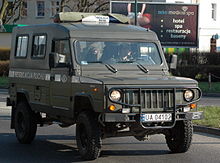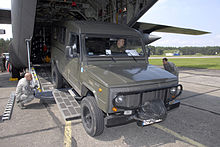Honker
The Honker is a Polish car brand for the Polish off-road vehicle of the same name from the manufacturer DZT Tymińscy , which has been producing the vehicle series since 2009. The model series looks back on an eventful history. It was produced by various manufacturers from 1988 to 2007 (1988–1996 in Poznań , then in Lublin). Since 2012, the plant in Lublin has been spun off as an independent company Fabryka Samochodów Honker . Honker is the successor to the FSR Tarpan (1973 to 1994)
history
Work on the first Polish off-road vehicle began in the late 1970s at Fabryka Samochodów Rolniczych "Polmo" w Poznaniu . The CI-1 prototype was presented in 1984. It is an all-terrain vehicle of the Tarpan Honker type, developed in 1982 by an army institute in Sulejowek and built by FSR Posen from 1988 to 1996 . The Tarpan Honker 4012 and 4022 types were manufactured from 1988 to 1996, followed by the 10-bed hardtop and 4022 (army vehicle) models . Under Daewoo, the Lublin plant received an order for two successor models from 1997 to 2001. The model was then continued to be built under Andoria-Mot and Intrall until 2007. The buyers were various state institutions, especially the army. In addition, a special model was exported to Iraq as an ambulance . The largest private customer was KGHM Polska Miedź (copper mining), which transported workers underground by car.
The Honker 4032 ("Scout") model followed later and production was relocated from Poznan to Lublin and manufactured by Daewoo Motor Polska from 1997 to 2001 under license. Daewoo completely redesigned the interior of the vehicle and launched it as the Honker 2324 . In September 2000, the revised Daewoo Honker 2000 followed with only cosmetic changes.
After the collapse of Daewoo Motor Polska , the model was continued by Andoria-Mot (2002 to 2003), after which Intrall Polska took over production (see Fabryka Samochodów Ciężarowych ). The off-road version was called Honker MAX (April 2004, Intrall Honker since 2005 ) and the 5-door Honker (2006). There were hardtop models, pick-ups and pick-ups. The petrol engines used the engine from the FSO Polonez , the diesel version the engine from the Iveco (2.5 dm³) and the models since 1997 the turbo engines Andoria 4CT90 (later 4CTi90). The standard versions had three doors and leaf suspension. In 2004 the Honker Skorpion model was presented, 90 of which were delivered to the Polish Army in autumn 2007 for troop transport to Iraq. In spring 2007, production was stopped, and Intrall was insolvent due to the failure of a van.
From November 2008 to January 2009, the trustee tried to sell the rights for the honker and the production of elements for car and garage doors. Finally, the production of the Honker was outsourced to the Warsaw company Igma - pojazdy specjalne i opancerzone and DZT Tymińscy for a period of one year . The negotiations on the final sale lasted several months, and the contract was finally awarded for 43 million złoty DZT Tymińscy for all rights to the car brand including the assembly hall, paint shop, welding shop, stamping shop, research and development. The conditions included a. the further production in Lublin and the guarantee of guarantee and service for at least 10 years.
In addition to a few prototypes for marketing purposes, there are orders from mining companies for use in copper mines. In 2009, the Polish Army purchased 2,466 units in various versions and ordered a further 60 vehicles in 2010.
vehicles
| model | plant | Years of production |
|---|---|---|
| Honker 4x4 | Lublin | Since 2009 |
| Honker Cargo | Lublin | January 3, 2011–2016 |
| DZT Honker pick-up | Lublin | Since 2012 |
Honker was first introduced in 1988 and has been in production since 1996. The DZT has been offering 4 versions since 2009: the Scorpion for industry , a model for military use since September 2011, the civilian version Honker 4x4 and the pick-up.
Honker Cargo
The Honker Cargo is a modular van and was presented in 2010 as the DZT Pasagon . The vehicle is based on the construction of the Intrall Lublin. It is delivered in different versions. Series production started in January 2011. It is intended for the Polish market and for export, mainly to Arab and African countries. The bodywork has been revised under Janusz Kaniewski since 2012.
Honker 4x4
The Honker 4x4 is the off-road vehicle model of the Honker. The development of the vehicle series is shown in the article Honker. Since 1998 the vehicle has been produced as the successor to the Tarpan , which is successfully used by the Polish military, e.g. B. Iraq. In addition to the military versions, civil versions are also produced in the hard-top, soft-top and pick-up versions. The vehicle is homologated for the entire EU and complies with the EURO 5 emissions standards, which means that it can also be approved in Germany. Is used a four cylinder - diesel engine 2600 cc displacement and 85 kW or 115 horsepower, a torque of 250 Nm (at 1800 to 2400 min -1 has).
Web links
- Manufacturer's website (last version in the web archive from May 25, 2019)
- Visit to the Honker production facility in Lublin
Individual evidence
- ↑ Barbara Majewska: Igma chce w Lublinie produkować honkera. Kurier Lubelski, February 10, 2009.
- ↑ Tchnęli nowe życie w lubelskiego honkera. Kurier Lubelski, May 24, 2009.
- ↑ Mateusz Multarzyński: Następca Honkera, czyli kolejny trudny wybór in: Nowa Technika Wojskowa No. 4/2009, p. 45.
- ↑ wyborcza.biz: Wojsko się namyśliło. Kupuje 60 lubelskich honkerów November 22, 2010
- ↑ Honker 4 × 4 (PDF; 251 kB). Technical data of the Honker 4x4 (in the web archive of January 7, 2018)


